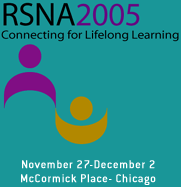
Abstract Archives of the RSNA, 2005
LPD08-04
Middle Cerebral Artery Susceptibility Sign on T2*-weighted Gradient-Echo Images before Thrombolysis: Association with Recanalization and Clinical Outcome in Hyperacute Ischemic Stroke
Scientific Posters
Presented on November 28, 2005
Presented as part of LPD08: Neuroradiology/Head and Neck (Stroke: Diagnosis)
Kyung A Kim, Presenter: Nothing to Disclose
Ho Sung Kim, Abstract Co-Author: Nothing to Disclose
Deok Hee Lee, Abstract Co-Author: Nothing to Disclose
Choong Gon Choi, Abstract Co-Author: Nothing to Disclose
Sang Joon Kim MD, Abstract Co-Author: Nothing to Disclose
Dae Chul Suh, Abstract Co-Author: Nothing to Disclose
Purpose. To evaluate the association of middle cerebral artery susceptibility sign on T2*-weighted image before thrombolysis with recanalization and clinical outcome in patients with hyperacute ischemic stroke.
Materials and Methods. 42 patients who met inclusion criteria were enrolled in this study. Two neuroradiologists who were blinded to clinical information and other imaging data independently evaluated middle cerebral artery susceptibility sign before thrombolysis. Thrombolytic treatments were performed with either intravenous or intraarterial drug administration. Differences of dosage of thrombolytic drugs and Thrombolysis in Myocardial Infarction (TIMI) flow grade on digital subtraction angiography or MR angiography between patients with and those without the susceptibility sign were assessed with the Mann-Whitney U test. Clinical outcome was measured using the modified Rankin scale (mRS) 30 days later and categorized as favorable (mRS 0–2), poor (mRS 3–5), or death (mRS 6).
Results. The positive susceptibility sign (17 patients) was correlated with vascular occlusion on digital subtraction angiography or MR angiography. The mean dosage of drugs was not statistically different between the two groups but TIMI grade after thrombolysis was higher in patients with a positive susceptibility sign (2.2 vs 1.0, p <.05). Multivariate logistic regression analysis showed that this sign was not associated with favorable functional outcome 30 adys after thrombolytic treatment.
Conclusion: The middle cerebral artery susceptibility sign is indicative of the immediate effectiveness of thrombolysis. However, this sign is not associated with favorable functional clinical outcome after thrombolysis in our small series study.
Purpose. To evaluate the association of middle cerebral artery susceptibility sign on T2*-weighted image before thrombolysis with recanalization and clinical outcome in patients with hyperacute ischemic stroke.
Materials and Methods. 42 patients who met inclusion criteria were enrolled in this study. Two neuroradiologists who were blinded to clinical information and other imaging data independently evaluated middle cerebral artery susceptibility sign before thrombolysis. Thrombolytic treatments were performed with either intravenous or intraarterial drug administration. Differences of dosage of thrombolytic drugs and Thrombolysis in Myocardial Infarction (TIMI) flow grade on digital subtraction angiography or MR angiography between patients with and those without the susceptibility sign were assessed with the Mann-Whitney U test. Clinical outcome was measured using the modified Rankin scale (mRS) 30 days later and categorized as favorable (mRS 0–2), poor (mRS 3–5), or death (mRS 6).
Results. The positive susceptibility sign (17 patients) was correlated with vascular occlusion on digital subtraction angiography or MR angiography. The mean dosage of drugs was not statistically different between the two groups but TIMI grade after thrombolysis was higher in patients with a positive susceptibility sign (2.2 vs 1.0, p <.05). Multivariate logistic regression analysis showed that this sign was not associated with favorable functional outcome 30 adys after thrombolytic treatment.
Conclusion: The middle cerebral artery susceptibility sign is indicative of the immediate effectiveness of thrombolysis. However, this sign is not associated with favorable functional clinical outcome after thrombolysis in our small series study.
Kim, K,
Kim, H,
Lee, D,
Choi, C,
Kim, S,
Suh, D,
Middle Cerebral Artery Susceptibility Sign on T2*-weighted Gradient-Echo Images before Thrombolysis: Association with Recanalization and Clinical Outcome in Hyperacute Ischemic Stroke. Radiological Society of North America 2005 Scientific Assembly and Annual Meeting, November 27 - December 2, 2005 ,Chicago IL.
http://archive.rsna.org/2005/4412208.html

